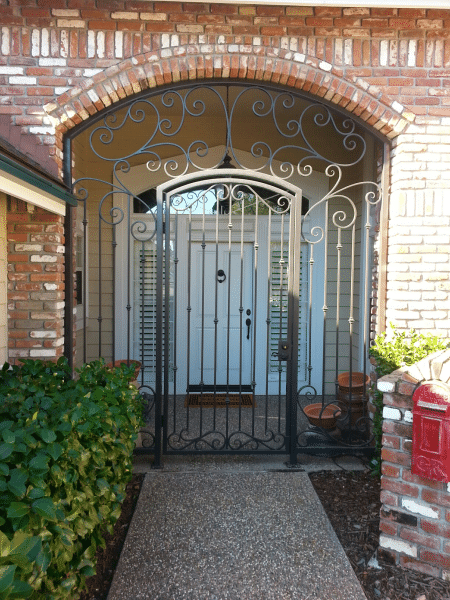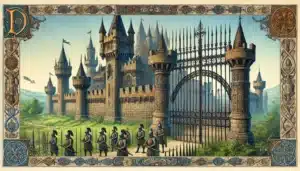Deciding on the right gate for your home, whether iron or wood, is more than just a choice; it’s an investment in the aesthetic and security of your space. Many of our clients come to us with the pivotal question: “What sets your iron gates apart from wooden ones?” To simplify your decision-making process, we’ve evaluated both materials across four crucial criteria:
- Design Flexibility: This measures the breadth of options available to personalize your gate’s design, ensuring it reflects your unique style.
- Security: This assesses each material’s durability against damage and the elements, along with its effectiveness in preventing unauthorized access.
- Durability: This considers how long your gate is expected to last before needing replacement.
- Maintenance Needs: This examines the frequency and extent of maintenance required to keep your gate in prime condition.
Not sure what material is best for you? Take our quiz.
Design Customization: Iron vs. Wood
Iron Gates: The malleability of wrought iron once heated allows for unparalleled customization. From intricate scrollwork to elegantly detailed posts, every element can be tailored. Although iron gates often feature gaps between bars, creative design solutions can minimize this issue, offering both elegance and personalization.
Wood Gates: Offering a seamless design without gaps, wood gates present a solid, cohesive appearance. However, their inability to be molded like iron means custom details must be applied atop the base material, potentially obscuring your home’s façade rather than enhancing it.
Security: A Comparative Look
Iron Gates: Known for their strength, iron gates can withstand significant impact, bending without breaking. The spacing between bars is their only minor vulnerability, requiring an extremely slim intruder to exploit.
Wood Gates: When crafted from high-quality wood and properly reinforced, wooden gates rival iron in security. Their main drawback is the climbable smooth tops, alongside a tendency to splinter under severe force.
Durability: Iron’s Timelessness vs. Wood’s Warmth
Iron Gates: A well-made iron gate can last for decades, surviving beyond its owner’s lifespan with minimal issues, save for potential rust in certain climates which can be mitigated with quality treatments.
Wood Gates: With correct sealing and reinforcement, wooden gates also promise longevity. Yet, they’re more prone to weathering and physical damage, requiring more vigilant care over time.

Maintenance: Keeping Your Gate Pristine
Iron Gates: Maintenance generally involves rust repair, which, while potentially costly, is infrequent thanks to durable coatings that protect for years or even decades.
Wood Gates: Wood gate maintenance is more common, dealing with rot, sagging, or wear. Though repairs can be simpler and cheaper than iron, they’re needed more often.
Your Decision: Iron or Wood?
While we, as an ornamental iron company, have our preference, the choice ultimately depends on your priorities. Both iron and wood gates offer distinct advantages and can significantly enhance your home’s appeal and security.
Cost Considerations and Longevity
On average, metal fences tend to be pricier than wood, but the investment might be justified by their durability and aesthetic value. Wrought iron fences, with proper care, can grace your property for over 60 years, far outlasting wooden alternatives.
Final Thoughts
Our fabricators are eager to transform your home. Get My Free Design Consult
Your home’s gate is more than a barrier; it’s a statement of style and a commitment to security. Whether you lean towards the timeless elegance of iron or the natural charm of wood, make sure it reflects your taste and meets your needs. For those drawn to the strength and durability of metal, our team is ready to bring your vision to life with a free design consultation.
Remember, the best gate is one that you’ll be proud to open every day. Choose wisely, and transform your home into a fortified sanctuary of beauty.
Quick Comparison
| Feature | Iron Gates | Wood Gates |
|---|---|---|
| Design Customizability | High customizability with options for intricate designs and details. Gaps between bars can be creatively managed. | Good customizability, but designs are added atop the base material. No gaps between panels for a seamless look. |
| Security | Extremely durable and resistant to force. Gaps between bars may pose minimal security concerns. | Strong when made from high-quality, reinforced wood. Smooth tops can be climbable. Prone to splintering under excessive force. |
| Longevity | Can last for decades with minimal maintenance. Resistant to most damage, except for potential rust in certain climates. | Durable with proper treatment, but more susceptible to weathering and physical damage than iron. |
| Maintenance | Low maintenance. Occasional rust repair may be required, which can be costly but is infrequent. | More frequent maintenance to address rot, sagging, and wear. Repairs can be simpler and cheaper than iron but are needed more often. |
| Cost | Generally more expensive upfront, but long-term durability may offset initial costs. | Less expensive upfront but may incur higher maintenance costs over time. |
| Aesthetic Appeal | Offers an elegant, classic look that can complement the architectural style of a home. | Provides a warm, natural appearance that can blend well with the surrounding landscape. |
| Ideal Use | Suited for properties requiring high security and a timeless design. | Best for those seeking a natural look and willing to invest in regular upkeep. |



